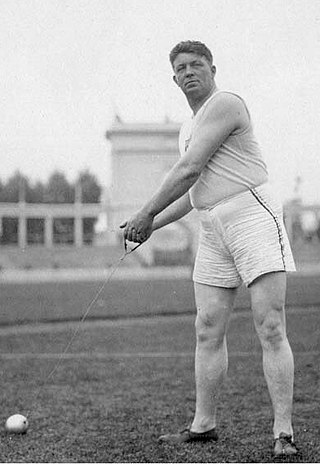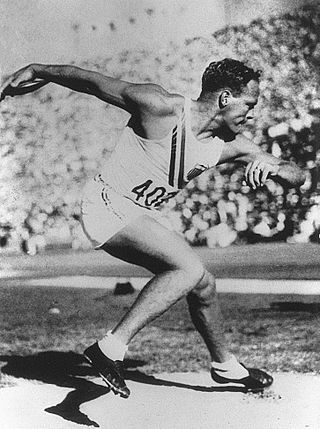
Matthew John McGrath was a member of the Irish American Athletic Club, the New York Athletic Club, and the New York City Police Department. At the time of his death at age 64, he attained the rank of Police Inspector, and during his career received the NYPD's Medal of Valor twice. He competed for the U.S. team in the Olympics in 1908, 1912, 1920 and 1924. In his prime, he was known as "one of the world's greatest weight throwers."

Canada competed at the 1912 Summer Olympics in Stockholm, Sweden. 37 competitors, all men, took part in 30 events in 7 sports.

John Joseph Flanagan was an Irish-American three-time Olympic gold medalist in the hammer throw, winning in 1900, 1904, and 1908.

The men's hammer throw was one of six throwing events on the Athletics at the 1908 Summer Olympics programme in London. The competition was held on July 14, 1908. 19 throwers from eight nations competed. NOCs could enter up to 12 athletes. The event was won by American John Flanagan, his third consecutive victory in the event. He was the first man to win three medals in the hammer throw and, as of the 2016 Games, the only one to win three gold medals in the event. The silver medal went to fellow American Matt McGrath. Con Walsh of Canada took bronze and became the first athlete not from the United States to win a medal in the event, as the Americans had swept the podium in both 1900 and 1904. The three medalists were all part of the Irish Whales.

The men's 200 metres was a track and field athletics event held as part of the Athletics at the 1912 Summer Olympics programme. It was the fourth appearance of the event, which has appeared at every edition of the Summer Olympics since the 1900 Summer Olympics. The competition was held on July 10, 1912, and on July 11, 1912. 61 runners from 19 nations competed. NOCs could enter up to 12 athletes. The event was won by Ralph Craig of the United States, the nation's third victory in four Games. Another American, Donald Lippincott, took silver. Great Britain earned its first medal in the 200 metres with Willie Applegarth's bronze.

The men's 400 metres was a track and field athletics event held as part of the Athletics at the 1912 Summer Olympics programme. The competition was held on Friday, July 12, 1912, and on Saturday, July 13, 1912. Forty-nine runners from 16 nations competed. NOCs could enter up to 12 athletes. The event was won by Charles Reidpath of the United States, the nation's fourth title in the event. Hanns Braun of Germany took silver, the nation's first medal in the men's 400 metres.

Hungary competed at the 1912 Summer Olympics in Stockholm, Sweden. Austrian and Hungarian results at early Olympic Games are generally kept separate despite the union of the two nations as Austria-Hungary at the time. 121 competitors, all men, took part in 52 events in 11 sports.

The men's hammer throw was a track and field athletics event held as part of the Athletics at the 1904 Summer Olympics programme. It was the second time the event was held. The competition was held on Monday, August 29, 1904. Six athletes from the United States competed. John Flanagan, the reigning champion, defended his gold medal and set a new Olympic record. John DeWitt took silver and Ralph Rose bronze. It was the second consecutive medal sweep for the United States in the event. Flanagan was the first man to earn multiple medals in the event; he would finish with three consecutive victories, a record not matched by anyone in the hammer throw.

The men's 56 pound weight throw was a track and field athletics event held as part of the Athletics at the 1904 Summer Olympics programme. It was the first time the event was held. It would not appear on the Olympic program again until the 1920 Summer Olympics, which would be the last time the 56 pound weight was thrown in the Olympic Games. The competition was held on September 1, 1904. 6 athletes from 2 nations competed. The event was won by Étienne Desmarteau of Canada, one of only two gold medals in athletics won by an athlete not from the United States. Americans John Flanagan and James Mitchel took second and third, respectively.

The men's long jump was a track and field athletics event held as part of the athletics at the 1912 Summer Olympics programme. The competition was held on Friday, July 12, 1912. Thirty long jumpers from 13 nations competed. NOCs could enter up to 12 athletes. The event was won by Albert Gutterson of the United States, the nation's fifth gold medal in the event in five Games. Calvin Bricker of Canada became the second man to win a second medal in the long jump, adding a silver to his 1908 bronze. Sweden won its first long jump medal with Georg Åberg's bronze.
The men's pole vault was a track and field athletics event held as part of the Athletics at the 1912 Summer Olympics programme. It was the fifth appearance of the event, which is one of 12 to have been held at every Summer Olympics. The competition was held on Wednesday, July 10, 1912, and on Thursday, July 11, 1912. Twenty-five pole vaulters from eleven nations competed. NOCs could enter up to 12 athletes. It was the second straight Games in which more than 3 medals were awarded in the event. The event was won by Harry Babcock of the United States, the nation's fifth consecutive victory in the event. Fellow Americans Frank Nelson and Marc Wright tied for second and were both awarded silver; normally, this would have constituted a medal sweep. However, bronze medals were awarded to the three men tied for fourth place. This put both Canada and Sweden on the podium for the second consecutive Games and awarded the United States a total of four medals in the 1912 pole vault.

The men's shot put was a track and field athletics event held as part of the athletics at the 1912 Summer Olympics programme. The competition was held on Wednesday, July 10, 1912. Twenty-two shot putters from 14 nations competed. NOCs could enter up to 12 athletes. The event was won by Pat McDonald of the United States, the nation's fifth consecutive victory in the men's shot put. The American team swept the top three places, the third time in five Games. Ralph Rose took silver, 9 centimetres shy of a third gold medal; he became the first man to win three medals of any color.

The men's discus throw was a track and field athletics event held as part of the athletics at the 1912 Summer Olympics programme. The competition was held on Friday, July 12, 1912. Forty-one discus throwers from 15 nation competed. NOCs could enter up to 12 athletes. The event was won by Armas Taipale of Finland, the nation's first medal in the men's discus throw. Richard Byrd took silver and James Duncan took bronze to continue the United States' podium streak at five consecutive Games.

The men's hammer throw event was part of the track and field athletics programme at the 1920 Summer Olympics. The competition was held on Wednesday, August 18, 1920. 12 throwers from 5 nations competed; four from Sweden, four from the United States, two from Canada, one from Great Britain, and one from Finland. No nation had more than 4 athletes, suggesting the limit had been reduced from the 12 maximum in force in 1908 and 1912. The event was won by Patrick Ryan of the United States, the nation's fifth consecutive victory in the event. Carl Johan Lind took silver, earning Sweden's first medal in the hammer throw. Another American, Basil Bennett, earned bronze.

The men's hammer throw event was part of the track and field athletics programme at the 1924 Summer Olympics. The competition was held on Thursday, July 10, 1924. 15 hammer throwers from ten nations competed. The maximum number of athletes per nation was 4. The event was won by Fred Tootell of the United States, the nation's sixth consecutive victory in the event; the Americans would not win again until 1956. Tootell was the first of the winners to have been born in the United States; the previous winners had all been Irish-American. Fellow American Matt McGrath, the 1908 silver medalist and 1912 champion, took silver once again; he was the second man to earn three medals in the hammer throw. Malcolm Nokes earned Great Britain's first medal in the event with his bronze.

The men's hammer throw event was part of the track and field athletics programme at the 1928 Summer Olympics. The competition was held on Monday, July 30, 1928. Sixteen hammer throwers from eleven nations competed. The maximum number of athletes per nation was 4. The event was won by Pat O'Callaghan of Ireland, the first gold medal for the nation at the Olympics since it started competing independently in 1924 and the first time the event was won by a non-American. Ossian Skiöld of Sweden took silver, the nation's second medal in the event after another silver in 1920. The Americans, who had earned a gold medal and at least one other medal in each of the previous six hammer throw competitions, took only a bronze this time, with Edmund Black finishing third.

The men's discus throw event at the 1932 Olympic Games took place August 3. Eighteen athletes from 11 nations competed. The 1930 Olympic Congress in Berlin had reduced the limit from 4 athletes per NOC to 3 athletes. The event was won by John Anderson of the United States, the nation's third consecutive and sixth overall victory in the men's discus throw. Henri LaBorde took silver, marking the first time since 1908 that the same nation had the top two discus throwers. Paul Winter was the bronze medalist, earning France's first discus medal. Finland's four-Games podium streak ended, while the United States extended its streak to all nine appearances of the event.

The men's hammer throw event at the 1932 Olympic Games took place August 1. There were 14 competitors from 9 nations. The 1930 Olympic Congress in Berlin had reduced the limit from 4 athletes per NOC to 3 athletes. The event was won by Pat O'Callaghan of Ireland, repeating as Olympic champion. O'Callaghan was the third man to win multiple hammer throw medals and the second to repeat as gold medalist. His victory also made 7 of the first 8 Olympic hammer throw competitions won by Irish-born athletes; in addition to O'Callaghan's two victories for Ireland, five of the United States' wins were by Irish-American throwers. Ville Pörhölä took silver for Finland's first medal in the event. Peter Zaremba extended the United States' medal streak to eight Games with his bronze.

The men's hammer throw event was part of the track and field athletics programme at the 1936 Summer Olympics. The competition took place on August 3, 1936, with 27 competitors from 16 nations. The maximum number of athletes per nation had been set at 3 since the 1930 Olympic Congress. The final was won by Karl Hein of Germany. The silver medal went to Erwin Blask, also of Germany. They were the first medals for Germany in the event; Germany was also the first country other than the United States to have two medalists in the event in the same Games. Fred Warngård of Sweden took bronze. The United States' eight-Games medal streak in the hammer throw was snapped, with the Americans' best result being William Rowe's fifth place.

The men's hammer throw competition at the 1968 Summer Olympics in Mexico City, Mexico took place on October 16–17. There were 22 competitors from 12 nations. The maximum number of athletes per nation had been set at 3 since the 1930 Olympic Congress. The event was won by Gyula Zsivótzky of Hungary, who had taken silver in both 1960 and 1964; he was the third man to win three medals in the hammer throw (after John Flanagan and Matt McGrath. Zsivótzky defeated defending champion Romuald Klim of the Soviet Union, who earned silver this time to become the sixth man to win multiple medals in the event. Bronze went to Lázár Lovász of Hungary.

















